Chapter 3. The Cellular Level of Organization
3.2 The Nucleus and DNA Replication
Learning Objectives
By the end of this section, you will be able to:
- Describe the structure and features of the nuclear membrane
- List the contents of the nucleus
- Explain the organization of the DNA molecule within the nucleus
- Describe the process of DNA replication
The nucleus is the largest and most prominent of a cell’s organelles (Figure 3.2.1). The nucleus is generally considered the control center of the cell because it stores all of the genetic instructions for manufacturing proteins. Interestingly, some cells in the body, such as muscle cells, contain more than one nucleus (Figure 3.2.2), which is known as “multinucleated.” Other cells, such as mammalian red blood cells (RBCs), do not contain nuclei at all. RBCs eject their nuclei as they mature, making space for the large numbers of hemoglobin molecules that carry oxygen throughout the body (Figure 3.2.3). Without nuclei, the life span of RBCs is short, and so the body must produce new ones constantly.
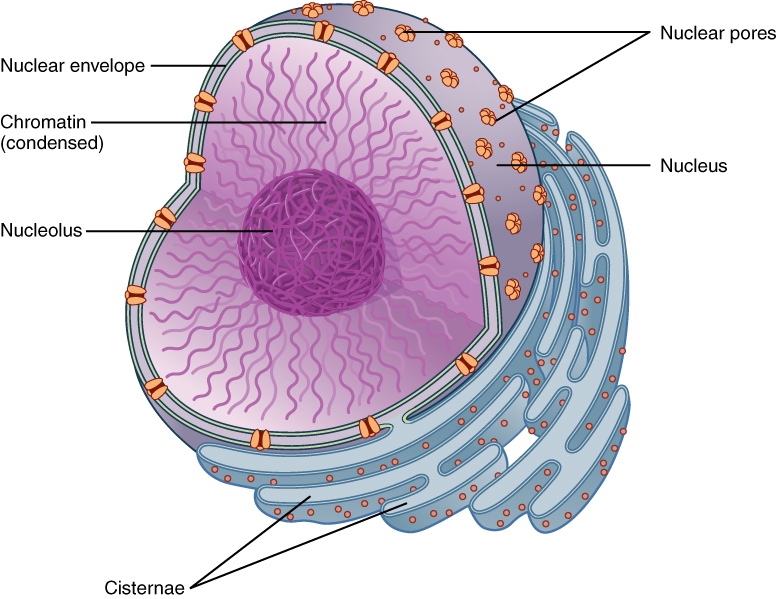
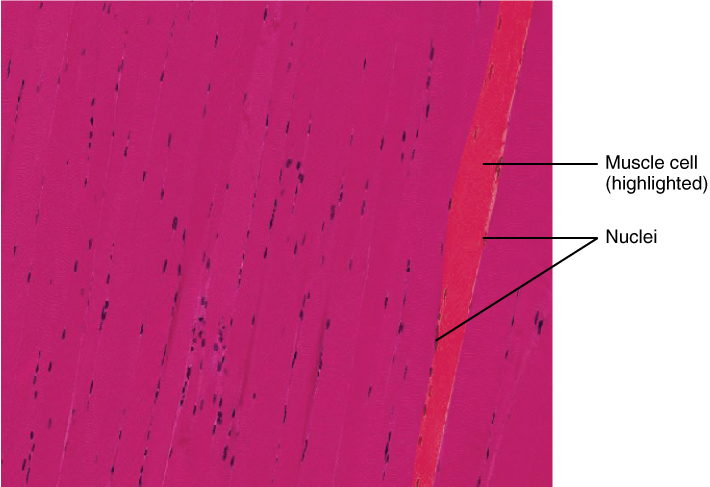
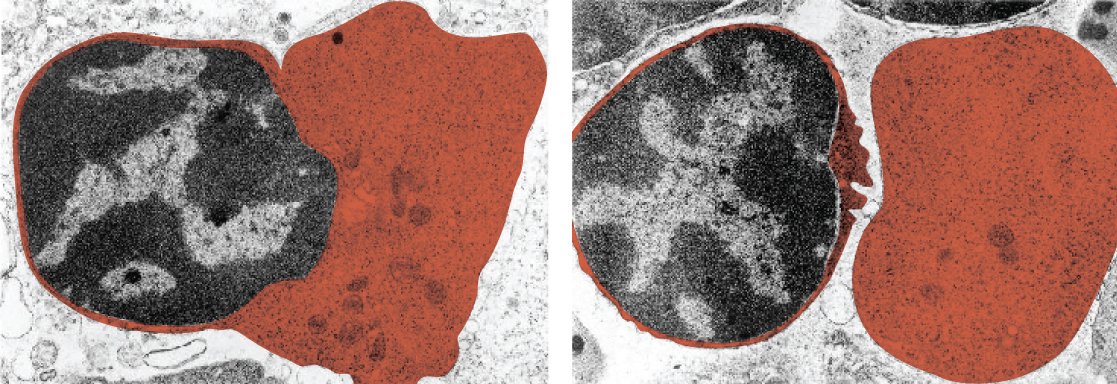
Inside the nucleus lies the blueprint that dictates everything a cell will do and all of the products it will make. This information is stored within DNA. The nucleus sends “commands” to the cell via molecular messengers that translate the information from the DNA. Each cell in your body (with the exception of germ cells) contains the complete set of your DNA. When a cell divides, the DNA must be duplicated so that each new cell receives a full complement of DNA. The following section will explore the structure of the nucleus and its contents, as well as the process of DNA replication.
Organization of the Nucleus and Its DNA
Like most other cellular organelles, the nucleus is surrounded by a membrane called the nuclear envelope. This membranous covering consists of two adjacent lipid bilayers with a thin fluid space in between them. Spanning these two bilayers are nuclear pores. A nuclear pore is a tiny passageway for the passage of proteins, RNA, and solutes between the nucleus and the cytoplasm. Proteins called pore complexes lining the nuclear pores regulate the passage of materials into and out of the nucleus.
Inside the nuclear envelope is a gel-like nucleoplasm with solutes that include the building blocks of nucleic acids. There also can be a dark-staining mass often visible under a simple light microscope, called a nucleolus (plural nucleoli). The nucleolus is a region of the nucleus that is responsible for manufacturing the RNA necessary for construction of ribosomes. Once synthesized, newly made ribosomal subunits exit the cell’s nucleus through the nuclear pores.
The genetic instructions that are used to build and maintain an organism are arranged in an orderly manner in strands of DNA. Within the nucleus are threads of chromatin composed of DNA and associated proteins (Figure 3.2.4). Along the chromatin threads, the DNA is wrapped around a set of histone proteins. A nucleosome is a single wrapped DNA-histone complex. Multiple nucleosomes along the entire molecule of DNA appear like a beaded necklace, in which the string is the DNA and the beads are the associated histones. When a cell is in the process of division, the chromatin condenses into chromosomes, so that the DNA can be safely transported to the “daughter cells.” The chromosome is composed of DNA and proteins; it is the condensed form of chromatin. It is estimated that humans have almost 22,000 genes distributed on 46 chromosomes.
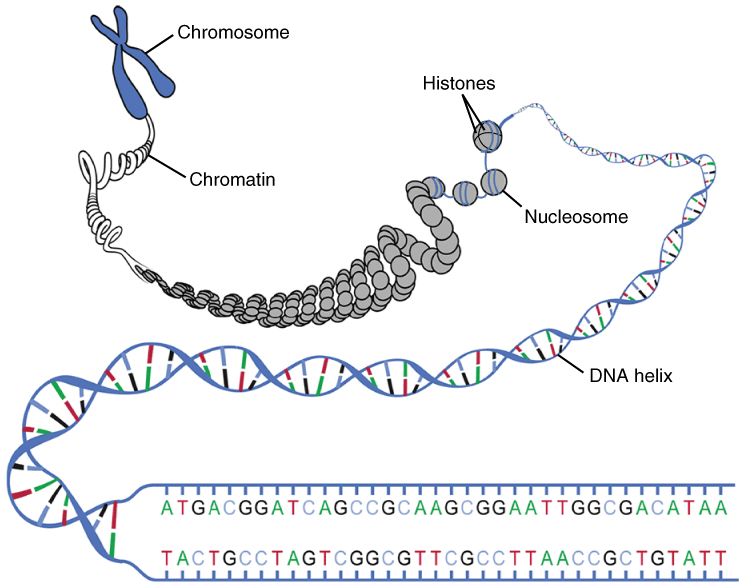
DNA Replication
In order for an organism to grow, develop, and maintain its health, cells must reproduce themselves by dividing to produce two new daughter cells, each with the full complement of DNA as found in the original cell. Billions of new cells are produced in an adult human every day. Only very few cell types in the body do not divide, including nerve cells, skeletal muscle fibers, and cardiac muscle cells. The division time of different cell types varies. Epithelial cells of the skin and gastrointestinal lining, for instance, divide very frequently to replace those that are constantly being rubbed off of the surface by friction.
A DNA molecule is made of two strands that “complement” each other in the sense that the molecules that compose the strands fit together and bind to each other, creating a double-stranded molecule that looks much like a long, twisted ladder. Each side rail of the DNA ladder is composed of alternating sugar and phosphate groups (Figure 3.2.5). The two sides of the ladder are not identical, but they are complementary. These two backbones are bonded to each other across pairs of protruding bases, each bonded pair forming one “rung,” or cross member. The four DNA bases are adenine (A), thymine (T), cytosine (C), and guanine (G). Because of their shape and charge, the two bases that compose a pair always bond together. Adenine always binds with thymine, and cytosine always binds with guanine. The particular sequence of bases along the DNA molecule determines the genetic code. Therefore, if the two complementary strands of DNA were pulled apart, you could infer the order of the bases in one strand from the bases in the other complementary strand. For example, if one strand has a region with the sequence AGTGCCT, then the sequence of the complementary strand would be TCACGGA.
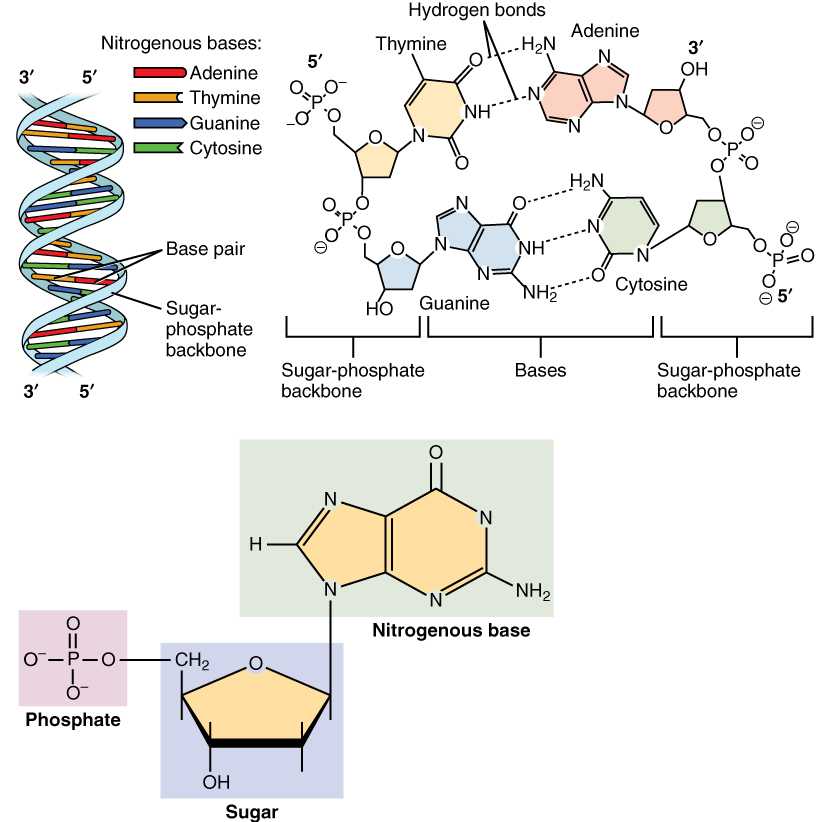
DNA replication is the copying of DNA that occurs before cell division can take place. After a great deal of debate and experimentation, the general method of DNA replication was deduced in 1958 by two scientists in California, Matthew Meselson and Franklin Stahl. This method is illustrated in Figure 3.2.6 and described below.
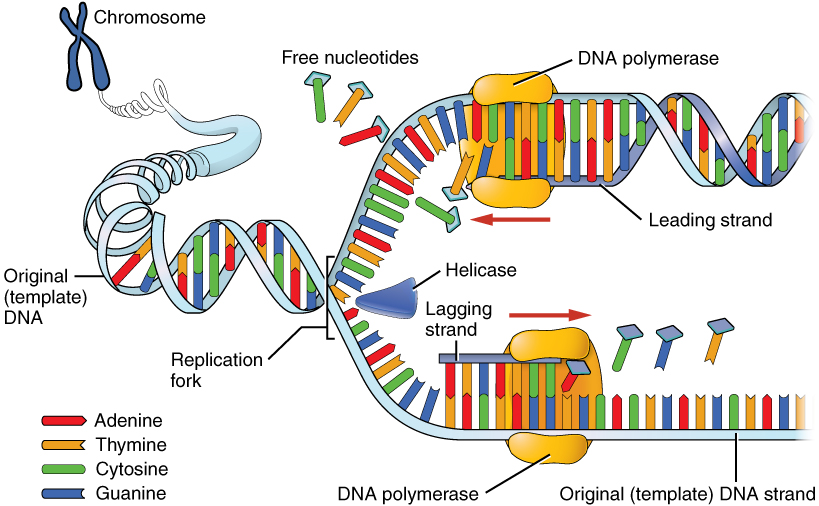
Stage 1: Initiation. The two complementary strands are separated, much like unzipping a zipper. Special enzymes, including helicase, untwist and separate the two strands of DNA.
Stage 2: Elongation. Each strand becomes a template along which a new complementary strand is built. DNA polymerase brings in the correct bases to complement the template strand, synthesizing a new strand base by base. A DNA polymerase is an enzyme that adds free nucleotides to the end of a chain of DNA, making a new double strand. This growing strand continues to be built until it has fully complemented the template strand.
Stage 3: Termination. Once the two original strands are bound to their own finished complementary strands, DNA replication is stopped and the two new identical DNA molecules are complete.
Each new DNA molecule contains one strand from the original molecule and one newly synthesized strand. The term for this mode of replication is “semiconservative,” because half of the original DNA molecule is conserved in each new DNA molecule. This process continues until the cell’s entire genome, the entire complement of an organism’s DNA, is replicated. As you might imagine, it is very important that DNA replication take place precisely so that new cells in the body contain the exact same genetic material as their parent cells. Mistakes made during DNA replication, such as the accidental addition of an inappropriate nucleotide, have the potential to render a gene dysfunctional or useless. Fortunately, there are mechanisms in place to minimize such mistakes. A DNA proofreading process enlists the help of special enzymes that scan the newly synthesized molecule for mistakes and corrects them. Once the process of DNA replication is complete, the cell is ready to divide. You will explore the process of cell division later in the chapter.
External Website
 Watch this video from Bozeman Science to learn about DNA replication. DNA replication proceeds simultaneously at several sites on the same molecule. What separates the base pair at the start of DNA replication?
Watch this video from Bozeman Science to learn about DNA replication. DNA replication proceeds simultaneously at several sites on the same molecule. What separates the base pair at the start of DNA replication?
Section Review
The nucleus is the command center of the cell, containing the genetic instructions for all of the materials a cell will make (and thus all of its functions it can perform). The nucleus is encased within a membrane of two interconnected lipid bilayers, side by side. This nuclear envelope is studded with protein-lined pores that allow materials to be trafficked into and out of the nucleus. The nucleus contains one or more nucleoli, which serve as sites for ribosome synthesis. The nucleus houses the genetic material of the cell: DNA. DNA is normally found as a loosely contained structure called chromatin within the nucleus, where it is wound up and associated with a variety of histone proteins. When a cell is about to divide, the chromatin coils tightly and condenses to form chromosomes.
There is a pool of cells constantly dividing within your body. The result is billions of new cells being created each day. Before any cell is ready to divide, it must replicate its DNA so that each new daughter cell will receive an exact copy of the organism’s genome. A variety of enzymes are enlisted during DNA replication. These enzymes unwind the DNA molecule, separate the two strands, and assist with the building of complementary strands along each parent strand. The original DNA strands serve as templates from which the nucleotide sequence of the new strands are determined and synthesized. When replication is completed, two identical DNA molecules exist. Each one contains one original strand and one newly synthesized complementary strand.
Interactive Link Questions
Watch this video to learn about DNA replication.
Video 3.2. DNA Replication by Bozeman Science
Review Questions
Critical Thinking Questions
Glossary
- chromatin
- threads composed of DNA and associated proteins within the nucleus
- chromosomes
- condensed forms of chromatin that appear when a cell is in the process of division
- DNA
- deoxyribonucleic acid, the blueprint that dictates everything a cell will do and all of the products it will make, stored within the nucleus
- DNA polymerase
- an enzyme that brings in the correct bases to complement the template strand, synthesizing a new strand base by base
- DNA replication
- the process of copying DNA that occurs before cell division can take place
- genome
- all of the DNA contained within the nucleus of a cell
- helicase
- an enzyme that untwists and separates the two strands of DNA during DNA replication
- histone proteins
- proteins around which DNA is wrapped along the chromatin threads
- nuclear envelope
- a membrane surrounding the nucleus, consisting of two adjacent lipid bilayers with a thin fluid space in between them
- nuclear pores
- tiny passageways for the passage of proteins, RNA, and solutes between the nucleus and the cytoplasm
- nucleolus
- a region of the nucleus responsible for manufacturing the RNA necessary for the construction of ribosomes
- nucleosome
- a single wrapped DNA-histone complex
- nucleus
- the largest and most prominent of a cell’s internal structures, considered the control center of the cell because it stores all of the genetic instructions for manufacturing proteins
Glossary Flashcards
This work, Human Physiology, is adapted from Anatomy & Physiology by OpenStax, licensed under CC BY. This edition, with revised content and artwork, is licensed under CC BY-SA except where otherwise noted.
Images from Anatomy & Physiology by OpenStax are licensed under CC BY except where otherwise noted.
Access the original for free at OpenStax.
Image Descriptions
Figure 3.2.1. A detailed cross-sectional diagram of a cell nucleus and its surrounding structures. The large spherical nucleus occupies the center, filled with light purple chromatin depicted as wavy strands. A darker purple, densely coiled nucleolus sits at the nucleus center. The nucleus is enclosed by a double-layered nuclear envelope (shown in gray) studded with orange nuclear pores that allow transport between the nucleus and cytoplasm. Surrounding the nucleus are blue flattened sacs of the rough endoplasmic reticulum (cisternae), which are studded with small red dots representing ribosomes. The diagram labels point to the nuclear envelope, nuclear pores, chromatin (condensed), nucleolus, nucleus, and cisternae. [Return to Figure 3.2.1]
Figure 3.2.2. A light microscopy image of cardiac muscle tissue stained bright magenta. The tissue shows elongated muscle cells running diagonally across the field of view. One muscle cell on the right side is highlighted in a brighter red-orange color to distinguish it from surrounding cells. Scattered throughout the magenta tissue are small, dark purple, elongated oval structures labeled as nuclei. These nuclei appear as short dashes or rod-like shapes distributed among the muscle fibers, indicating the locations of individual cell nuclei within the cardiac muscle tissue. [Return to Figure 3.2.2]
Figure 3.2.3. Two side-by-side electron microscopy images of eukaryotic cells with artificial coloring. Each image shows large cells outlined in red. Within each cell are two distinct regions: a dark gray to black nucleus containing white and light gray patches representing chromatin, and a red-orange colored area representing the cytoplasm. The left image shows an irregularly shaped cell with the nucleus positioned on the left side and cytoplasm extending to the right. The right image displays a more rounded cell with a circular nucleus on the left and cytoplasm on the right. The grainy black texture in the nuclei contrasts with the smoother red-orange cytoplasm, clearly delineating these two cellular compartments. The white background surrounding the cells represents the extracellular space. [Return to Figure 3.2.3]
Figure 3.2.4. A multi-level diagram illustrating how DNA is packaged within eukaryotic cells, progressing from simple to complex structures. At the bottom, two rows show the DNA sequence with letters (A, T, G, C) color-coded: adenine (A) in green, thymine (T) in red, guanine (G) in gray, and cytosine (C) in blue. Above this, the DNA double helix is depicted as two intertwined blue strands with colored base pairs connecting them like rungs on a twisted ladder. Moving upward, the DNA wraps around gray spherical nucleosomes (protein complexes of histones, shown as small gray circles) forming a beaded “string of pearls” structure. This nucleosome chain then coils into a thicker chromatin fiber shown in gray with continued DNA wrapping. At the top left, the chromatin further condenses into the familiar X-shaped blue chromosome structure seen during cell division. Labels point to each organizational level: DNA helix, histones, nucleosomes, chromatin, and chromosome, demonstrating the progressive compaction of genetic material. [Return to Figure 3.2.4]
Figure 3.2.5. A multi-part diagram illustrating DNA structure and composition. The upper left shows a DNA double helix with the two strands labeled 3′ and 5′ at each end. The nitrogenous bases are color-coded: adenine (red), thymine (orange), guanine (blue), and cytosine (green). The sugar-phosphate backbone forms the outer structure with base pairs connecting the two strands internally. The upper right displays the molecular structure of two base pairs. The top pair shows adenine (pink-shaded) hydrogen bonding to thymine (yellow-shaded) with two dashed lines representing hydrogen bonds. The bottom shows guanine (light blue-shaded) bonding to cytosine (light green-shaded) with three hydrogen bonds. Each nucleotide includes a sugar molecule (pentagon shape) connected to a phosphate group, with the bases extending inward to form pairs. The lower portion breaks down a single nucleotide into its three components: a phosphate group (pink-shaded, showing P bonded to oxygen atoms), a five-carbon sugar molecule (blue-shaded pentagon with OH group), and a nitrogenous base (yellow-shaded, shown as guanine with its double-ring structure and NH2 group). [Return to Figure 3.2.5]
Figure 3.2.6. A detailed diagram illustrating the process of DNA replication. At the top left, a blue X-shaped chromosome uncoils into the double helix structure. The diagram shows the original template DNA strands (gray backbone) splitting at a Y-shaped replication fork. A blue wedge-shaped helicase enzyme is positioned at the fork, unwinding the double helix. Free nucleotides (shown as colored bars: red for adenine, yellow for thymine, green for cytosine, and blue for guanine) float nearby, ready to be incorporated. Two yellow DNA polymerase enzymes are shown synthesizing new DNA strands. The top strand (leading strand) is synthesized continuously in the direction of the replication fork (indicated by a red arrow pointing right). The bottom strand (lagging strand) is synthesized discontinuously in the opposite direction (red arrow pointing left). The newly synthesized DNA strands have the same color-coded base pairs as the originals, maintaining the complementary base pairing: adenine with thymine (red-yellow) and cytosine with guanine (green-blue). The result is two identical DNA double helices extending to the right, each consisting of one original template strand and one newly synthesized strand. [Return to Figure 3.2.6]
Report an Error
Did you find an error, typo, broken link, or other problem in the text? Please follow this link to the error reporting form to submit an error report to the authors.
